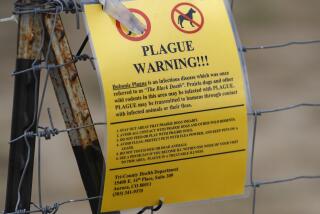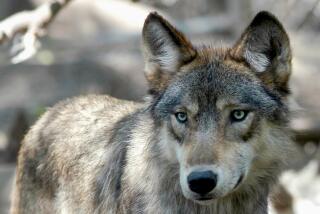Ferret Recovery Hampered by Plague, Politics
- Share via
MALTA, Mont. — The once-high hopes of reintroducing one of North America’s rarest mammals in Montana have diminished this year--the indirect victim of a plague by Mother Nature and land management politics of humans.
For the first time in six years, officials at the Charles M. Russell National Wildlife Refuge in north-central Montana have decided not to introduce any more black-footed ferrets at the refuge, considered the second most successful reintroduction site in the country.
“I don’t think there’s much more potential for ferrets to do much more there than they already are,” said Mike Lockhart, ferret recovery coordinator for the U.S. Fish and Wildlife Service in Laramie, Wyo. “The habitat, frankly, is pretty limiting. It’s too small and too fragmented.”
The decision not to introduce ferrets this year has less to do with ferrets than it does with the prairie dog, a small burrowing rodent.
Prairie dogs not only make up more than 90% of the ferrets’ diet, they build and then begrudgingly share their intricate system of underground tunnels with the ferrets.
But sylvatic plague, known as the bubonic plague in humans, has killed off prairie dogs on thousands of acres in the region since the early 1990s.
The plague, which is spread by fleas and hard to predict, struck again this year on the Ft. Belknap Indian Reservation in northern Montana, another reintroduction site.
Some wildlife officials say the plague is not the only culprit. They contend management of public lands that has permitted--sometimes advocated--the shooting of prairie dogs has compounded the losses.
For years, the sport shooting of prairie dogs has been widely accepted in Montana and other areas where the animals thrive. Defenders say the prairie dog shoots are a valuable control method. The events also bring welcome business to the small rural towns.
But environmentalists have become more vocal in calling for an end to the activity after learning that the ferrets were being reintroduced into prairie dog areas.
“It’s as much political, I suppose, as it is biological at this point,” said Marc Whisler, wildlife biologist with the Bureau of Land Management.
The BLM, which for years permitted prairie dog shooting on its land, has changed its policy. The agency imposed a mandatory ban late last year on 15 prairie dog towns where ferret reintroduction efforts are underway or planned.
John Grensten, a wildlife biologist for BLM, said the agency is trying hard to juggle its responsibility to protect the ferret and its requirement to allow public access to the land.
It has not been easy.
“I’ve always had the philosophy that if all sides are upset, we’re probably doing a good job,” Grensten said.
The Fish and Wildlife Service has said prairie dog losses from plague, poisons, shooting and other factors have become so high, the prairie dog itself may be warranted for listing as a threatened species.
For those trying to increase the black-footed ferret population, the losses have added up to a significant disappointment.
“Things are bleaker now than we thought even three or four years ago,” said Lockhart, of the Fish and Wildlife Service. “We’re struggling for ferrets to be recovered in any meaningful way in the near future.”
Ferrets were once thought to be extinct or near extinct. But a remnant population was discovered in 1981 on a ranch near Meeteetse, Wyo.
Reintroductions began in 1991 in Wyoming and have occurred in a handful of other Western states since. As of last year, about 1,200 ferrets had been reintroduced into the wild, but with just moderate success.
The goal is to establish at least 10 separate, self-sustaining populations with a total number of 1,500 ferrets by 2010.
So far, just six sites in North America have been identified as high quality--healthy enough to sustain a growing ferret population. A number of those are in South Dakota and so far have been unaffected by plague.
Reintroductions also have been successful at the Buffalo Gap National Grasslands site in southwest South Dakota. About 25 “kits,” or juvenile ferrets, from that site are expected to be sent to another site in the state.
At the Montana refuge, biologists are timid about reintroducing more ferrets right now. Although shooting is banned there and the plague has not been detected, they don’t want to add more ferrets until they are confident the prairie dog population both in the refuge and on adjacent land is healthy and growing.
“We’ll see what the [ferret] population does on its own and continue monitoring it,” said Randy Matchett, a biologist at the refuge. “We’re really limited to what we can do here.”
“Am I optimistic? No. But you’ve got to try,” he added.
At Ft. Belknap, where officials counted only a half-dozen ferrets last spring and just one new litter this year, more ferret releases are planned this fall, despite the plague outbreak.
Tim Vosburgh, a tribal biologist, admits it’s a gamble.
“This year is going to be critical in determining whether ferrets will be on Ft. Belknap,” he said.
More to Read
Sign up for Essential California
The most important California stories and recommendations in your inbox every morning.
You may occasionally receive promotional content from the Los Angeles Times.













